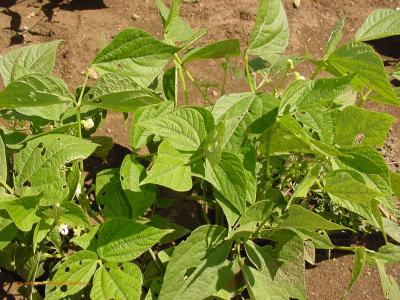The bean is a tender, warm season vegetable that ranks second to tomato in popularity in home gardens. Beans can be classified by growth habit (bush or pole), use (immature pods, seeds, and dry beans), and the type (green, yellow, white). Bush Beans stand erect without support. They yield well and require the least amount of work. Green bush beans were formerly called "string beans" because fiber developed along the seams of the pods. Plant breeders have reduced these fibers through selection and green beans are now referred to as "snap beans." Pole Beans climb supports and are easily harvested. Seeds of most varieties tend to crack and germinate poorly if the soil's moisture content is too high. For this reason, never soak bean seed before planting. Instead water just after planting or plant right before a heavy rain. Beans have shallow roots and frequently shallow cultivation and hoeing are necessary to control small weeds and grasses. Because bean plants have fairly weak root systems, deep, close cultivation injures the plant roots, delays harvest and reduces yields.
Beans are sensitive to cold temperatures and frost. They should be planted after all danger of frost is past in the spring. If the soil has warmed before the average last-frost date, an early planting may be made a week to 10 days before this date. You can assure yourself a continuous supply of snap beans by planting every 2 to 4 weeks until early August.
Depends with the variety.
Green and wax beans are harvested when the pods are firm, crisp and fully elongated, but before the seed within the pod has developed significantly. Pick beans after the dew is off the plants, and they are thoroughly dry. Picking beans from wet plants can spread bean bacterial blight. Be careful not to break the stems or branches, which are brittle on most bean varieties. The bean plant continues to form new flowers and produces more beans if pods are continually removed before the seeds mature.
Lima beans (
P. lunatus) are harvested when the pods are plump and firm. Pods from different varieties vary in external appearance. It is very important to pick a few pods and test if they are ready for picking. Lima beans are of good quality when the seeds are not over mature. Harvest bush-type Lima beans in two to three pickings. The pole or vining types can be picked until the first frost if the old pods are removed before the beans mature.
Horticultural beans are harvested when the pods start changing color from green to yellow. The beans are fully formed at this stage. The beans are shelled from pods, and can be stored for a few days in a refrigerator.
Dry beans are harvested when the leaves have turned yellow and following of the plant naturally. Let the plants dry in the garden and pull up whole plants in the morning before the pods start to split. Split the pods to remove dry bean seeds. Alternatively you can pull dry bean plants before the pods are dry and dry the plants on a clean floor, and split the pods to remove bean seeds. Store bean seeds in jars or cans in a cool, dry location.
Plant seeds of all varieties one inch deep. Plant seeds of bush beans 2 to 4 inches apart in rows at least 18 to 24 inches apart. Plant seeds of pole beans 4 to 6 inches apart in rows 30 to 36 inches apart; or in hills (four to six seeds per hill) 30 inches apart, with 30 inches between rows.
Bacterial Disease
Environmental Damage
Fungal Disease
Herbicide Injury
Insect Damage
Additional pests and problems that may affect this plant:
Insect pests:
- Seed corn maggot
- Mexican bean beetle
- Black bean aphid
- Thrips
- Wireworm
Diseases:
- Asian soybean rust (Phakospora pachyrhizi)
- Sclerotina white mold (Sclerotinia sclerotiorum)
- Soybean cyst nematode (Heterodea glycine)
- Root knot nematodes (Meloidogyne spp.)
- Root Rots: Fusarium root rot (Fusarium solani), Pythium root rot (Pythium spp.), Rhizctonia root rot (Rhizoctonia solani), Thielaviopsis balck root rot (Thielaviopsis basicola)
- Virus Diseases: Common bean mosaic, Yellow mosaic
Environmental:
- Bronzing caused by ozone pollution
Require well-drained soil, and uniform moisture supply. Practice crop rotation to reduce build up of soil-borne diseases. Seeds of most beans tend to crack and germinate poorly when soil moisture content is very high. Do not soak bean seeds before planting or watered immediately after planting. Beans are shallow rooted so don't cultivate deeply closer to the stem.
